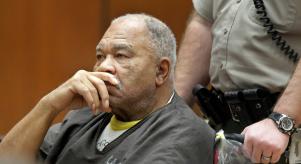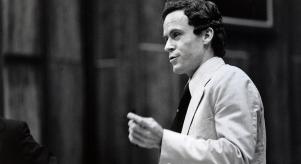
I am a Killer: Episode Guide
I am a Killer, is CI's new show where the killer takes centre stage. Over ten episodes each convicted prisoner recounts the events that led up to their crime and, shockingly, the event itself. We discover their motivations, their expectations and ultimately how they now view the crime, after time spent on death row. Different viewpoints and the impact of decisions made in a split second that have changed the course of the killers’ lives throw into question the viewer’s opinions towards the killers. Here's a taster of each of the episodes including a brief overview of each featured prisoner.
Episode 1. “Killer in the Eyes of the Law” Kenneth Foster
In August 1996 Michael LaHood was shot dead on the driveway of his parents’ house by Mauricio Brown. Sitting in a car 70 feet away sat Kenneth Foster, who was driving Mauricio Brown that night. In July 1997 both Kenneth Foster and shooter Mauricio Brown were found guilty of capital murder and sentenced to death. Brown was executed by lethal injection in 2006 while Foster’s execution was scheduled for August 30th 2007. However, following a high profile protest campaign, and just six hours before his scheduled execution, Foster’s sentence was altered to life in prison by Texas Governor Rick Perry.
Foster has now spent more than twenty years in prison, ten of those on death row, and he will not be eligible for parole until 2036. However, his family and supporters remain hopeful that his case may yet be heard by the Texas Board of Pardons and Parole. But for his case to be considered they require the backing of two out of three key public figures; one of whom is the District Attorney of Bexar County, San Antonio. However, the current District Attorney is Nico LaHood; brother of murdered Michael.
Episode 2. “Means to an End” James Robertson
Episode 3. “Mockingbird” Justin Dickens
Episode 4. “Sympathy for the Devil” Miguel Martinez
Episode 5. “Declared Competent” David Lewis
In 1986, while undertaking the burglary of a house in Lufkin, Texas, David Lee Lewis was surprised by the return of the homeowner, 74-year-old Myrtle Ruby. Lewis, who was armed with a sawn-off rifle, fired at Ruby and shot her dead. Having left distinctive footprints outside the crime scene, Lewis was arrested shortly afterwards and confessed to the crime. US Federal law prohibits States from executing the mentally disabled, which is defined as somebody with an IQ score of below 70. David Lewis’ IQ score has been officially recorded at ‘between 71 and 85’ meaning he is classified as “borderline” mentally impaired. His defence also argued that with alternative testing methods his IQ could be proven to be lower than 70.
However, the prosecution contended that Lewis should receive a death sentence on the grounds that he posed a future danger to society. They presented the jury with confessions that Lewis had displayed violent behaviour in a previous burglary incident; he had allegedly stabbed an individual when he was confronted while burgling another property only three months before Myrtle Ruby’s murder. David Lewis remains on death row more than 30 yearsafter the murder of Myrtle Ruby. His lawyers continue to insist that he is “is intellectually disabled and cognitively impaired” and have recently appealed the death penalty conviction on these grounds.
Episode 6 “Family Affair” Deandre Buchanan
On November 7th 2000, Deandre Buchanan was arrested near the scene of a triple homicide. Angela Brown, the mother of Buchanan’s two infant daughters, his stepfather and his aunt, had all been shot dead by Buchanan. In a recorded police interview, Buchanan claimed he had smoked a joint which had been laced with an unknown drug and that he had subsequently become convinced that everybody at the party were attempting to kill him. He described shooting both his step-father and aunt inside the house before chasing Angela Brown outside and shooting her dead as she held their children in herarms. Since that interview, Buchanan has consistently maintained that he has no recollection of what had taken place at the time of the shootings. In April 2002, Buchanan went on trial for the murders of Juanita Hoffman, William Jefferson and Angela Brown where he claimed that he had suffered a drug induced psychotic episode. Prosecutor Kevin Crane dismissed this claim of diminished responsibility on the grounds that any drugs Buchanan had taken had been consumed voluntarily. Crane also argued that Buchanan had deliberated over the killings when he reloaded the gun on more than one occasion and as such the killings constituted first degree murder. Buchanan is currently serving a life sentence, although he is actively trying to appeal his case with the hope of being given a reduced sentence. He maintains he was intoxicated at the time of the murder and not in his right mind.
Episode 7 “A Matter of Life and Death” Wayne Doty
In March 1997 Wayne Doty shot his colleague, Harvey Horne II, five times in the face over what Doty claimed was a dispute about drugs. Doty was given life in prison but 14 years later killed again. While in prison Doty tricked fellow inmate Xavier Rodriguez into being tied up before strangling him unconscious and then stabbing him 23 times with a homemade knife claiming Rodriguez had stolen tobacco from him. At his trial Doty represented himself encouraging the jury to sentence him to death, which they duly did. In October 2015, four years after his sentencing, Doty became the first Florida death row inmate to request the electric chair. Today, he remains on death row but only following a resentencing, which occurred during the filming of this documentary.
Episode 8 "Intended Evil" Charles Thompson
A crime of passion that ended in a double murder conviction. In 1998, Charles Thompson handed himself into police in Houston, Texas, for the shooting of his former girlfriend, Denise Hayslip, and her new partner Darren Cain. Both had allegedly been shot during a fight at Hayslip's home in which, according to Thompson, Cain had attacked him with a knife while Thompson claimed he had simply sought to defend himself. Cain was shot dead at the scene while Denise Hayslip, who according to Thompson had been accidentally hit in the jaw with a bullet, was taken to hospital for treatment. Thompson was initially charged with one count of manslaughter and one count of aggravated assault with a deadly weapon. However, when Denise Hayslip died in hospital six days later Thompson's charges were upgraded to double murder - a capital charge for which he faced the prospect of a death sentence.Thompson has continued to argue that he acted in self-defence and that Hayslip's death was due to medical error as she entered the hospital with non-life-threatening injuries. In 2001, Thompson succeeded in securing a second sentencing trial due to evidence which had been presented at the sentencing stage in his first trial. At that first trial, in order to demonstrate thatThompson was a "future danger to society (one of the requirements for a death sentence), the prosecution had played the jury a recording that an undercover police officer had made of Thompson in jail as he awaited trial. In that recording, Thompson attempted to solicit the undercover officer to assassinate the prosecution's key witness. By 2001, Thompson's lawyers had successfully argued that the recording was illegally obtained and should not have been played to the jury. Despite this damning recording being withheld as evidence in Thompson's second sentencing trial, the jury once again approved his death sentence.
Episode 9 "Hunted" Robert Shafer
Episode 10 “More than a Murderer” Joshua Nelson
In 1995, 18-year-old Joshua Nelson and 16-year-old co-defendant Keith Brennan were charged with the murder of their friend Tommy Owens in Cape Coral, Florida. The pair had brutally beaten and slit their friend’s throat with a box cutter. Nelson told investigators that they had decided to kill Tommy so that that they could steal his car and escape from their troubled home lives. Nelson even walked the police around the scene of the crime, a remote stretch of road about an hour from their home and told them in detail how they had killed Tommy. At trial, it was revealed that Nelson had been subjected to a sustained period of sexual abuse by his step-father and had been thrown out of the family home on the day of the killing. It was also claimed, but not proven, that a week before the murder Tommy Owens had sexually assaulted Keith Brennan’s girlfriend. However, a clear motive for the killing was never offered. Although Joshua Nelson was sentenced to death in November 1996, Keith Brennan avoided a death sentence due to his age. Nelson remains on Death Row more than 20 years after his conviction despite having launched various appeals. Nelson has now spent more than half of his life on Death Row.




